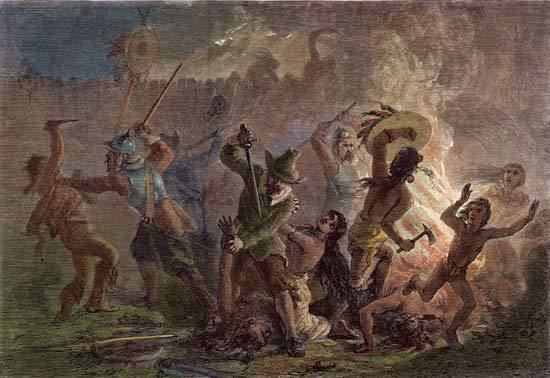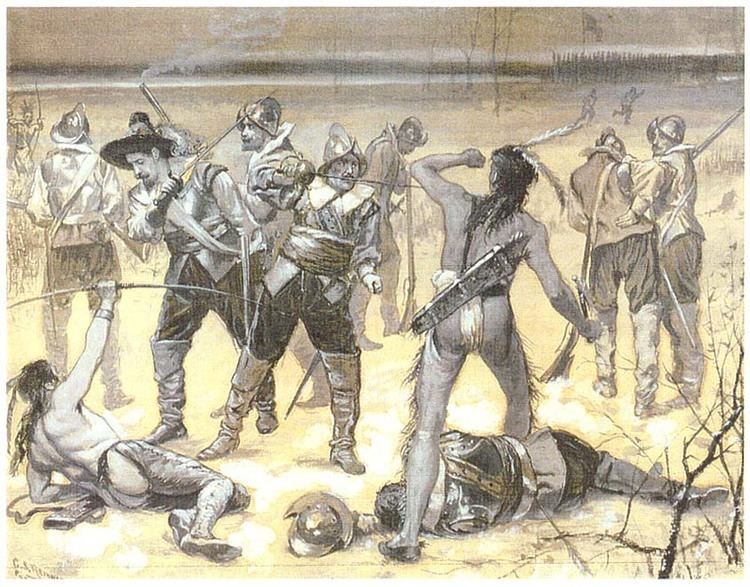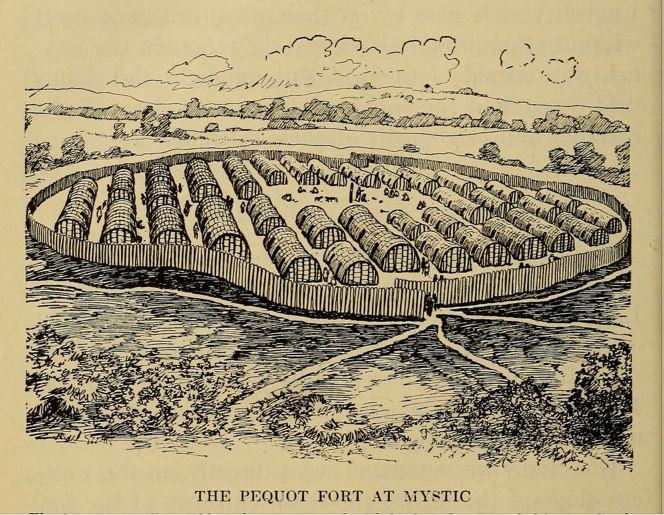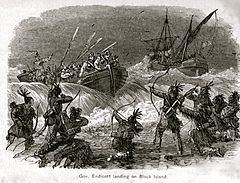 | ||
Period July 1636 – 21 September 1638 Combatants Pequot people, Massachusetts Bay Colony, Plymouth Colony Similar King Philip's War, Bacon's Rebellion, American Indian Wars, King William's War, Anglo‑Powhatan Wars | ||
Pequot war
The Pequot War was an armed conflict between the Pequot tribe and an alliance of the English colonists of the Massachusetts Bay, Plymouth, and Saybrook colonies and their Native American allies (the Narragansett and Mohegan tribes) which occurred between 1634 and 1638. The war concluded with the Pequots losing. At the end, about seven hundred Pequots had been killed or taken into captivity. Hundreds of prisoners were sold into slavery to the West Indies; other survivors were dispersed. The result was the elimination of the Pequot tribe as a viable polity in present-day Southern New England. The colonial authorities classified the tribe as extinct; however, survivors remained in the area and did regain recognition and land along the Thames and Mystic rivers in southeastern Connecticut.
Contents
- Pequot war
- Etymology
- Origins
- Belligerents
- Causes for war
- Battles
- Pequot raids
- The Mystic massacre
- Wars end
- Aftermath
- Historical accounts and controversies
- Documentaries
- References

Etymology

The name Pequot is a Mohegan term, the meaning of which is in dispute among Algonquian-language specialists. Most recent sources claim that "Pequot" comes from Paquatauoq (the destroyers), relying on the theories of early 20th-century authority on Algonquian languages Frank Speck, an anthropologist and specialist of Pequot-Mohegan in the 1920s–1930s. He had doubts about this etymology, believing that another term seemed more plausible, after translation relating to the "shallowness of a body of water".
Origins

The Pequots and their traditional enemies the Mohegans were a single sociopolitical entity at one time. Anthropologists and historians contend that they split into the two competing groups sometime before contact with the Puritan English. The earliest historians of the Pequot War speculated that the Pequots migrated from the upper Hudson River Valley toward central and eastern Connecticut sometime around 1500. These claims are disputed by the evidence of modern archaeology and anthropology finds.

In the 1630s, the Connecticut River Valley was in turmoil. The Pequots aggressively worked to extend their area of control, at the expense of the Wampanoags to the north, the Narragansetts to the east, the Connecticut River Valley Algonquians and Mohegans to the west, and the Algonquian people of Long Island to the south. The tribes contended for political dominance and control of the European fur trade. A series of smallpox epidemics over the course of the previous three decades had severely reduced the Native American populations due to their lack of immunity to the disease. As a result, there was a power vacuum in the area.

The Dutch and the English from Western Europe were also striving to extend the reach of their trade into the interior to achieve dominance in the lush, fertile region. The colonies were new at the time, the original settlements having been founded in the 1620s. By 1636, the Dutch had fortified their trading post, and the English had built a trading fort at Saybrook. English Puritans from Massachusetts Bay and Plymouth colonies settled at the four recently established river towns of Windsor (1632), Wethersfield (1633), Hartford (1635), and Springfield (1636.)
Belligerents

Causes for war
Before the war's inception, efforts to control fur trade access resulted in a series of escalating incidents and attacks that increased tensions on both sides. Political divisions widened between the Pequots and Mohegans as they aligned with different trade sources, the Mohegans with the English and the Pequots with the Dutch. (The peace did not last between the Dutch and Pequots.) The Pequots assaulted a tribe of Indians who had tried to trade in the area of Hartford. Tensions grew as the Massachusetts Bay Colony became a stronghold for wampum, which the Narragansetts and Pequots had controlled up until 1633. John Stone (English rogue, smuggler, and privateer) and about seven of his crew were murdered by the Niantics, Western tributary clients of the Pequots. According to the Pequots' later explanations, they murdered him in reprisal for the Dutch murdering the principal Pequot sachem Tatobem, and they claimed to be unaware that Stone was English and not Dutch. (Contemporaneous accounts claim that the Pequots knew Stone to be English.) In the earlier incident, Tatobem had boarded a Dutch vessel to trade. Instead of conducting trade, the Dutch seized the sachem and appealed for a substantial amount of ransom for his safe return. The Pequots quickly sent bushels of wampum, but received only Tatobem's dead body in return.
Stone was from the West Indies and had been banished from Boston for malfeasance, including drunkenness, adultery, and piracy. He was known to have powerful connections in other colonies, as well as in London, and he was expected to use them against the Boston colony. Setting sail from Boston, Stone abducted two Western Niantic men, forcing them to show him the way up the Connecticut River. Soon after, he and his crew were suddenly attacked and killed by a larger group of Western Niantic. The initial reactions in Boston varied from indifference to outright joy at Stone's death, but the colonial officials later decided to protest the killing. They did not accept the Pequots' excuses that they had been unaware of Stone's nationality. Pequot sachem Sassacus sent some wampum to atone for the killing, but refused the colonists' demands that the warriors responsible for Stone's death be turned over to them for trial and punishment.
On July 20, 1636, a respected trader named John Oldham was attacked on a trading voyage to Block Island. He and several of his crew were killed and his ship looted by Narragansett-allied Indians who sought to discourage English settlers from trading with their Pequot rivals. In the weeks that followed, colonial officials from Massachusetts Bay, Rhode Island, and Connecticut assumed that the Narragansetts were the likely culprits. The Puritan officials knew that the Indians of Block Island were allies of the Eastern Niantics, who were allied with the Narragansetts, and they became suspicious of the Narragansetts. The murderers meanwhile escaped and were given sanctuary with the Pequots.
Battles
News of Oldham's death became the subject of sermons in the Massachusetts Bay Colony. In August, Governor Vane sent John Endecott to exact revenge on the Indians of Block Island. Endecott's party of roughly 90 men sailed to Block Island and attacked two apparently abandoned Niantic villages. Most of the Niantic escaped, while two of Endecott's men were injured. The English claimed to have killed 14, but later Narragansett reports claimed that only one Indian was killed on the island. The Massachusetts Bay militia burned the villages to the ground. They carried away crops which the Niantic had stored for winter and destroyed what they could not carry. Endecott went on to Fort Saybrook.
The English at Saybrook were not happy about the raid, but agreed that some of them would accompany Endecott as guides. Endecott sailed along the coast to a Pequot village, where he repeated the previous year's demand for those responsible for the death of Stone, and now also for those who murdered Oldham. After some discussion, Endecott concluded that the Pequots were stalling and attacked, but most escaped into the woods. Endecott had his forces burn down the village and crops before sailing home.
Pequot raids
In the aftermath, the English of Connecticut Colony had to deal with the anger of the Pequots. The Pequots attempted to get their allies to join their cause, some 36 tributary villages, but were only partly effective. The Western Niantic (Nehantic) joined them, but the Eastern Niantic (Nehantic) remained neutral. The traditional enemies of the Pequot, the Mohegan and the Narragansett, openly sided with the English. The Narragansetts had warred with and lost territory to the Pequots in 1622. Now their friend Roger Williams urged the Narragansetts to side with the English against the Pequots.
Through the autumn and winter, Fort Saybrook was effectively besieged. People who ventured outside were killed. As spring arrived in 1637, the Pequots stepped up their raids on Connecticut towns. On April 23, Wongunk chief Sequin attacked Wethersfield with Pequot help. They killed six men and three women, a number of cattle and horses, and took two young girls captive. (They were daughters of William Swaine and were later ransomed by Dutch traders.) In all, the towns lost about thirty settlers.
In May, leaders of Connecticut river towns met in Hartford, raised a militia, and placed Captain John Mason in command. Mason set out with ninety militia and seventy Mohegan warriors under Uncas; their orders were to directly attack the Pequot at their fort. At Fort Saybrook, Captain Mason was joined by John Underhill with another twenty men. Underhill and Mason then sailed from Fort Saybrook to Narragansett Bay, a tactic intended to mislead Pequot spies along the shoreline into thinking that the English were not intending an attack. After gaining the support of 200 Narragansetts, Mason and Underhill marched their forces with Uncas and Wequash Cooke approximately twenty miles towards Mistick Fort (present-day Mystic). They briefly camped at Porter's Rocks near the head of the Mystic River before mounting a surprise attack just before dawn.
The Mystic massacre
The Mystic Massacre started in the predawn hours of May 26, 1637 when English forces led by Captains John Mason and John Underhill, along with their Indian allies from the Mohegan and Narragansett tribes, surrounded one of two main fortified Pequot villages at Mistick. Only 20 soldiers breached the palisade's gate and were quickly overwhelmed, to the point that they used fire to create chaos and facilitate their escape from within. The ensuing conflagration trapped the majority of the Pequots and caused their death; those who managed to exit were slain by the sword or musket from the others who surrounded the fort. Only a handful of approximately 500 men, women, and children survived what became known as the Battle of Mistick Fort. As the soldiers made the exhausted withdrawal march to their boats, they faced several attacks by frantic warriors from the other village of Weinshauks, but again the Pequots suffered very heavy losses versus relatively few by the Colonists.
Mason later declared that the attack against the Pequots was the act of a God who "laughed his Enemies and the Enemies of his People to scorn making [the Pequot fort] as a fiery Oven. ... Thus did the Lord judge among the Heathen, filling [Mystic] with dead Bodies." Of the estimated 500 Pequots present at Mystic that day, only seven survived to be taken prisoner, while another seven escaped to the woods.
The Narragansetts and Mohegans with Mason and Underhill's colonial militia were horrified by the actions and "manner of the Englishmen's fight ... because it is too furious, and slays too many men." The Narragansetts attempted to leave and return home but were cut off by the Pequots from the other village of Weinshauks and had to be rescued by Underhill's men—after which they reluctantly rejoined the colonists for protection and were utilized to carry the wounded, thereby freeing up more soldiers to fend off the numerous attacks along the withdrawal route.
War's end
The destruction of people and the village at Mistick Fort and losing even more warriors during the withdrawal pursuit broke the Pequot spirit, and they decided to abandon their villages and flee westward to seek refuge with the Mohawk tribe. Sassacus led roughly 400 warriors along the coast; when they crossed the Connecticut River, the Pequots killed three men whom they encountered near Fort Saybrook.
In mid-June, John Mason set out from Saybrook with 160 men and 40 Mohegan scouts led by Uncas. They caught up with the refugees at Sasqua, a Mattabesic village near present-day Fairfield, Connecticut. The colonists memorialized this event as the Fairfield Swamp Fight (not to be confused with the Great Swamp Fight during King Philip's War). The English surrounded the swamp and allowed several hundred to surrender, mostly women and children, but Sassacus slipped out before dawn with perhaps eighty warriors and continued west.
Sassacus and his followers had hoped to gain refuge among the Mohawk in present-day New York. However, the Mohawk instead murdered him and his bodyguard, afterwards sending his head and hands to Hartford (for reasons which were never made clear). This essentially ended the Pequot War; colonial officials continued to call for hunting down what remained of the Pequots after war's end, but they granted asylum to any who went to live with the Narragansetts or Mohegans.
Aftermath
In September, the Mohegans and Narragansetts met at the General Court of Connecticut and agreed on the disposition of the Pequot survivors. The agreement is known as the first Treaty of Hartford and was signed on September 21, 1638. About 200 Pequots survived the war; they finally gave up and submitted themselves under the authority of the sachem of the Mohegans or Naragansetts:
Other Pequots were enslaved and shipped to Bermuda or the West Indies, or were forced to become household slaves in English households in Connecticut and Massachusetts Bay. The Colonies essentially declared the Pequots extinct by prohibiting them from using the name any longer.
The colonists attributed their victory over the hostile Pequot tribe to an act of God:
This was the first instance wherein Algonquian peoples of southern New England encountered European-style warfare. After the Pequot War, there were no significant battles between Indians and southern New England colonists for about 38 years. This long period of peace came to an end in 1675 with King Philip's War.
Historical accounts and controversies
The earliest accounts of the Pequot War were written by the victors within one year of the war. Later histories, with few exceptions, recounted events from a similar perspective, restating arguments first used by the war's military leaders, such as John Underhill and John Mason, as well as Puritans Increase Mather and his son Cotton Mather.
Recent historians and others have reviewed these accounts. In 2004, an artist and archaeologist teamed up to evaluate the sequence of events in the Pequot War. Their popular history took issue with events and whether John Mason and John Underhill wrote the accounts that appeared under their names. The authors have been adopted as honorary members of the Lenape Pequots.
Most modern historians do not debate questions of the outcome of the battle or its chronology, such as Alfred A. Cave, a specialist in the ethnohistory of colonial America. However, Cave contends that Mason and Underhill's eyewitness accounts, as well as the contemporaneous histories of Mather and Hubbard, were more "polemical than substantive." The causes of the outbreak of hostilities, the reasons for the English fear of the Pequots, and the ways in which the English dealt with and wrote about the Pequots have been re-evaluated within a larger context than daily colonial life.
Some modern historians have placed the background of the Pequot War within the context of European history (in which religious wars gave rise to increased violence) and Dutch and English colonization in North America, as well as the ambitions and wars of contending Indian tribes during the first half of the 17th century. Such historians have doubts about traditional histories, characterizing them as hegemonic narratives that valorize Puritans at the expense of a "demonized" Indian population. Alden T. Vaughan, a noted historian of colonial America, at first was a critic of the Pequots. Later he wrote that the Pequots were not "solely or even primarily responsible" for the war. He went on, "The Bay colony's gross escalation of violence ... made all-out war unavoidable; until then, negotiation was at least conceivable."
